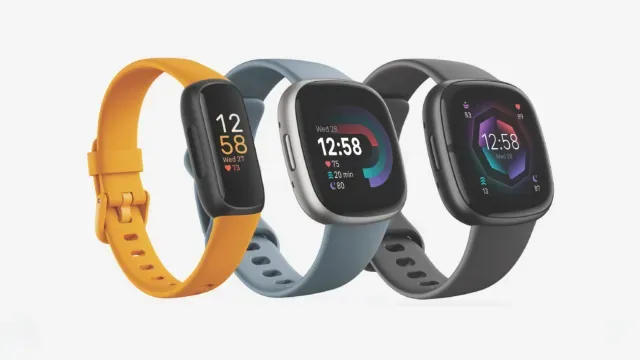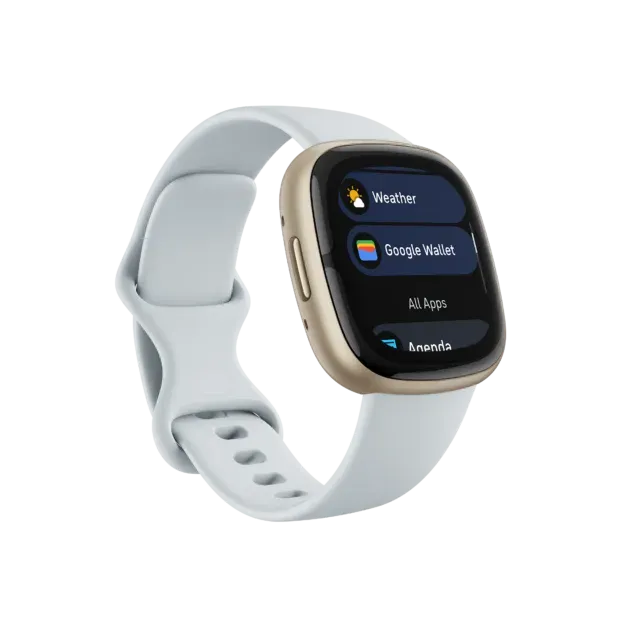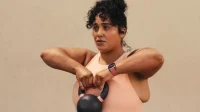Fitbit today announced the release of three new fitness trackers: the Inspire 3, Versa 4 and Sense 2. All are successors to the previous generation, and all three span the spectrum from the most feature-packed to the simplest fitness wearable.
“Basic” is a relative term among fitness trackers, as they all continually move closer to full-fledged smartwatch functionality. The Inspire 3, in particular, adds sleep oxygen monitoring and a full-color AMOLED touchscreen to an entry-level tracker that can already receive phone alerts such as texts, calls, and app notifications. Setting the display to an “always on”extra setting drops the battery life estimate from 10 days to just three, much more in line with a full-featured smartwatch, albeit less than the Fitbit Sense and Versa watches.
In contrast, the Sense 2 and Versa 4 are two of the most powerful trackers Fitbit has to offer. They’re both rated for roughly six days of use (with no always-on display enabled) and now have fast-charging capability that Fitbit claims can give you a day of battery life with just 12 minutes of charging.

The Sense 2 sits at the top of the Fitbit family, equipped with ECG sensors for atrial fibrillation detection (AFib), EDA (electrodermal activity) for stress measurement, GPS, blood oxygen and heart rate tracking. The previous Fitbit Sense had it all too. But Sense 2 builds on that, including new hardware and software for continuous (and therefore more useful) monitoring of atrial fibrillation and stress.
Fitbit is calling the new hardware a “Body Response”sensor that will track your stress levels throughout the day and alert you when you’re stressed. If he feels stressed, you’ll get guidance on guided breathing or meditation exercises that you can do either on your wrist or in the Fitbit app. The Sense 2 can actually receive on-demand EDA readings through the display itself, “using a method that turns metal into vapor, allowing [them] to integrate the metal electrodes of these sensors directly into the device’s display glass,”according to Fitbit. Sounds high-tech, but ultimately in the end it just means a slightly smaller box without a ring around it for the EDA readings.
A new algorithm for continuous monitoring of atrial fibrillation in one form or another has been developed since 2020, when Fitbit launched a heart study aimed at detecting atrial fibrillation. Before moving to the new Sense 2, the company proved that its algorithm could detect 98 percent of atrial fibrillation cases in a sample of more than 450,000 people.
Passive atrial fibrillation detection is available on the Sense 2, Sense, Versa 4, Versa 3, Versa 2, Inspire 3, Inspire 2, Charge 5, Charge 4, and Luxe trackers. But this only works when the user is asleep. It uses photoplethysmography (PPG) to detect changes in blood volume (and therefore heart rate) that may indicate signs of atrial fibrillation (AF). This is in addition to the Sense atrial fibrillation spot check sensor that existed in the previous generation of Sense. Spot checks require users to sit still with the palm of their hand over the display, while passive monitoring does not. Both the sensor and the PPG algorithm have been approved by the US Food and Drug Administration and are CE marked. , which means they meet US and EU safety, health and environmental requirements.
The Versa 4 doesn’t add any new hardware over the Versa 3, meaning there’s no Body Response sensor. Instead, it received a minor physical update, being slightly thinner and lighter, and bringing back a physical button for more reliable use.
In terms of user interface, both Sense 2 and Versa 4 have been redesigned to offer customizable data tiles versus the old static presets. Fitbit says Google Wallet and Google Maps will also be coming to these devices “in the coming months.”

At the same time, users can enjoy twice as many activity modes (over 40) on their new devices. It features modes for high-intensity interval training, weightlifting, crossfit, skiing/snowboarding, and dancing. Fitbit says it has no plans to bring these new activity modes to the previous generation Fitbit, but will “continue to evaluate the possibilities.”
However, one thing remains the same across all of these new devices: many of Fitbit’s most useful tools and insights (besides collecting raw data) are locked into the company’s Premium subscription. This includes daily readiness metrics to gauge your physical recovery and recommend suitable training options for each day, sleep profiles that help users understand their sleep patterns and how they might change over time, and health reports and metrics . health, which provide long-term (30 days per year) graphs, trends, and averages of a range of biological data, including heart rate variability, skin temperature, blood oxygen levels, sleep patterns, weight fluctuations, and activity levels.
The growing trend of paid data access in the world of fitness and wellness trackers is the bane of my existence. This only confirms that access to wellness and health can be measured by one indicator: wealth. Fitbit is offering six free months of Fitbit Premium for new users who purchase a Sense 2, Versa 4, or Inspire 3. Unfortunately for the Inspire, that’s six months less than what Fitbit was offering.
All three devices are available for pre-order starting today. The Sense 2 retails for $300 ($50 more than its predecessor), the Versa 4 for $230 ($30 more than the Versa 3’s starting price) and the Inspire 3 for $100 ($20 more than the Inspire’s original price). 2).
Listing image from Fitbit


